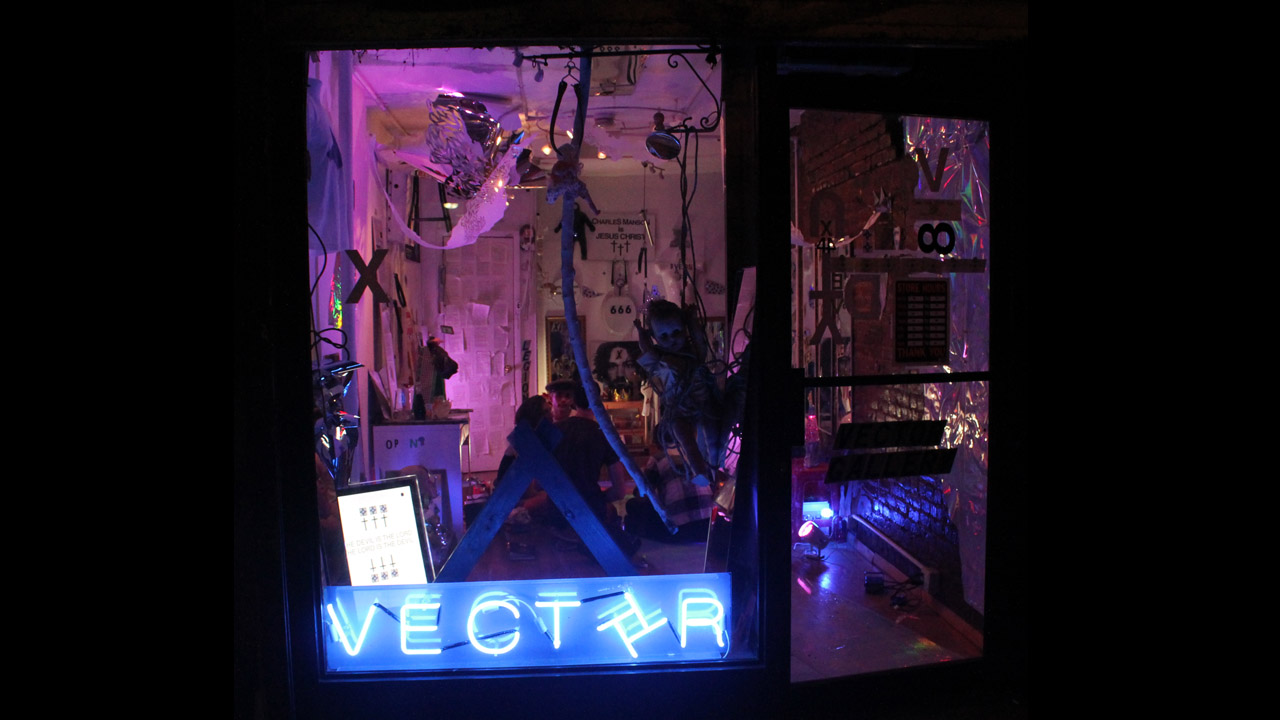 Vector — the “Official Gallery of Satan” — is located on the Lower East Side, as are many art galleries, but is often overlooked by critics. Could be the “Charles Manson is Jesus Christ” sign and weathervane in the “Abraxas Shrine” or the myriad of neon-lit doll parts and upside down Christian kitsch hanging in the window. Unlike most wildly accepted art, this art isn’t referencing Art or the Conversation of Art. Instead, it’s referencing a removed, already coherent body of symbology and history — Satanism. Thankfully, Art F City’s Whitney Kimball lives across the street and went in for a thorough review.
Vector — the “Official Gallery of Satan” — is located on the Lower East Side, as are many art galleries, but is often overlooked by critics. Could be the “Charles Manson is Jesus Christ” sign and weathervane in the “Abraxas Shrine” or the myriad of neon-lit doll parts and upside down Christian kitsch hanging in the window. Unlike most wildly accepted art, this art isn’t referencing Art or the Conversation of Art. Instead, it’s referencing a removed, already coherent body of symbology and history — Satanism. Thankfully, Art F City’s Whitney Kimball lives across the street and went in for a thorough review.
“Somebody wrote ‘Fuck you Satan-lover’ on the window,” Vector founder JJ Brine explained. “I like that it makes you choose a side.” Thing is… you can’t.
The “Abraxas Shrine” name is derived from Carl Jung’s Gnosticism — “a combination of both the Lord and the Devil, but more infinite than either.” On theme, it looks like much of the gallery’s objects employ assemblage, each part having its own, often oppositional weight — childhood toys and horrors of death, “evil” symbols cut out of luminescent stickers, etc. A sign inside reads “The Lord is the Devil, and the Devil is the Lord.”
This isn’t a new concept, but it’s also a personal idée fixe of mine. The closest example in art I’ve encountered so far has been Michael Craig Martin’s An Oak Tree — which was a sculpture of a glass of water on a glass shelf, but really “an oak tree.” Actually, it was verbalized clearest in one of the first and only interviews noise artist Pharmakon gave, explaining her name.
Pharmakon is an ancient Greek word; it means both poison and remedy, at the same time… The project is about duality, not juxtaposition, it is not about two things that are on opposite sides of the same spectrum, it is about two things that are opposite being the same thing…
Kimball obviously knows more than I do about art and parallel’s the gallery’s non-art subject (Satanism) directly to art history — “a religion based around opposing another religion” to the polemics of Modernism, its “ambiguity” to “20th century avant-garde” and its Gnostic themes to Duchamp’s theory of the infra-thin…
The possible, implying the becoming – the passage from one to the other takes place in the infra-thin.
The passage of the Devil as it becomes the Lord as it Becomes the Devil, the part where it is both the Devil and the Lord because they are the very opposites but not really, they are one and the same, they become one and the same in the infra-thin. Amirite?
Anyway, sounds fun. We gotta get down there. (Image: Art F City)



